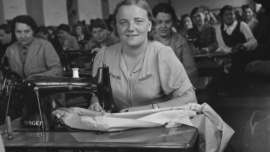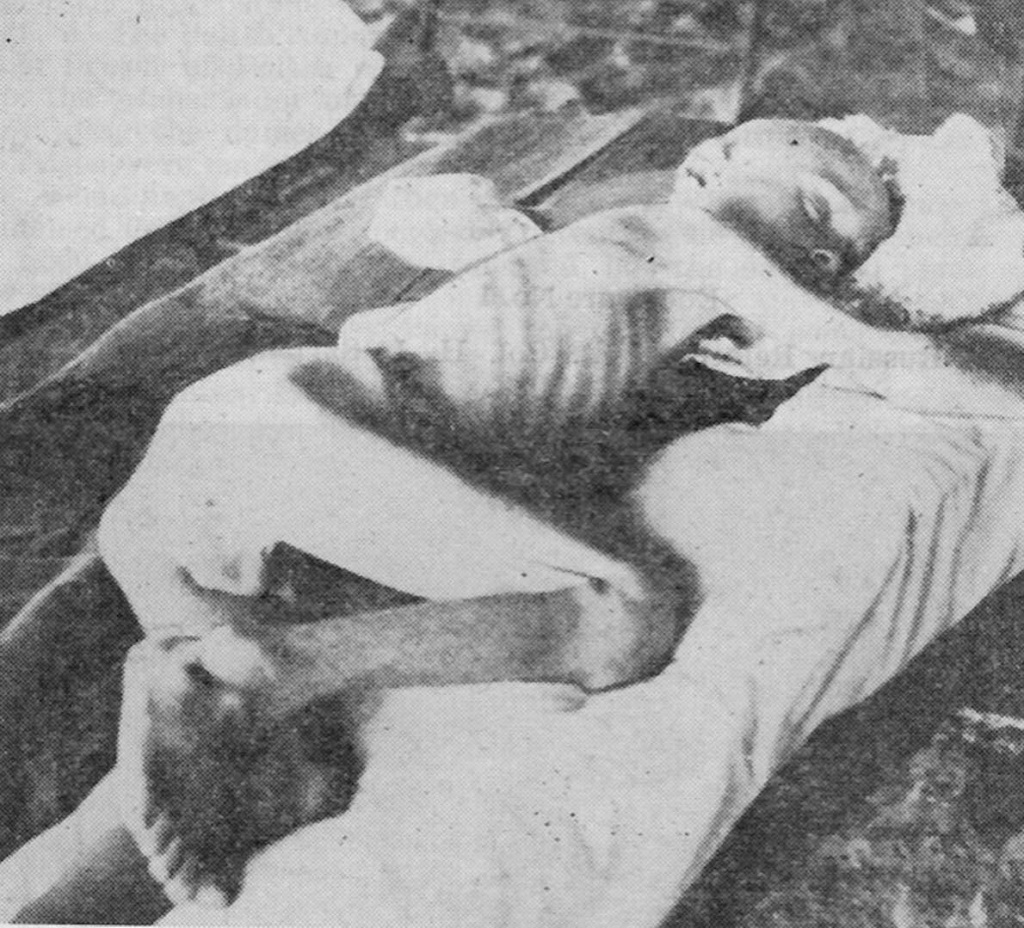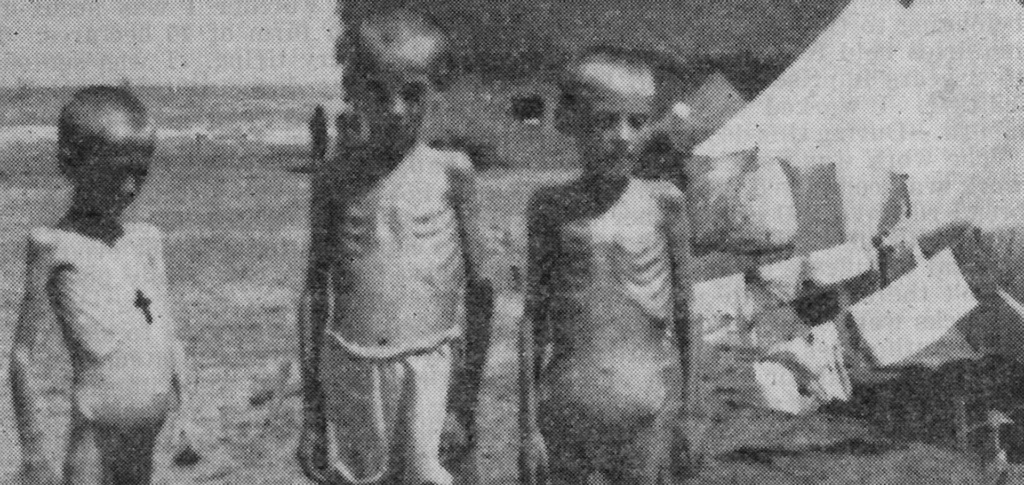U.S. Government Propaganda Photo, 1943
By Ted Lipien
A U.S. Government propaganda photo showing an unidentified Polish woman and other Polish women making their own clothing at a Red Cross refugee camp in Iran was taken by the Office of War Information (OWI) photographer in 1943. A few months earlier, the women were prisoners and slave laborers in the Soviet Union. By the time the photo was taken, the woman behind the sewing machine was safe, looked healthy and was no longer starving. With thousands of other Polish refugees she was in Iran being assisted by Polish, American and British authorities and private relief organizations, providing food and medical care. But before that, hundreds of thousands of Polish women, children and men had spent hellish two years in Soviet Russia as Stalin’s prisoners after being forcefully deported to Siberia and Soviet Central Asia.
We don’t know whether the healthy-looking Polish woman shown in the U.S. government propaganda photo was married, and, if she had a husband, whether he might have been executed or died in the Soviet Union. We don’t know if she had any children and whether any of them had lived. We also don’t know what she had to do in Russia to survive.
Very few Americans and other Westerners knew this story then, and very few know about it even today. To protect Stalin and the anti-Germany military alliance with Moscow, pro-Soviet propagandists in President Franklin D. Roosevelt’s administration did not publish photos of Polish men, women and children who were starved, ill and near death when they were evacuated from Soviet Russia to Iran in 1942. They did not tell the real stories of these refugees. On the contrary, they did everything possible to prevent Americans and the rest of the world, including listeners to U.S. government Voice of America (VOA) broadcasts, from getting true and complete information about Polish refugees evacuated from Russia.
The evacuees were even told by the Polish government-in-exile not to discuss what had happened to them in the Soviet Union. Stalin was still holding hundreds of thousands of Polish citizens as hostages, and the Polish government-in-exile was still trying to reach an accommodation with Moscow and to get them released. The Poles were also under strong pressure from Washington and London to appease Stalin who, however, had completely different plans for Poland and the rest of East Central Europe. The efforts to bring the remaining Poles from Russia to Iran failed. In April 1943, the Soviet government broke diplomatic relations with the Polish government in exile and forced Polish citizens in the Soviet Union to accept Soviet citizenship. Polish mothers were told that if they refused Soviet passports, their children would be sent to orphanages and they would be arrested and sent to the Gulag .
Naive U.S. propagandists said nothing about what might have happened to Polish women in Soviet captivity. Many had lost their husbands, children and close family members in Russia. Whole families, both the youngest and oldest members, were deported under brutal conditions from their homes in eastern Poland which had been occupied in 1939 by the Red Army under the secret terms of the Hitler-Stalin Pact. After Germany’s attack on the Soviet Union in 1941, poorly-informed U.S. propagandists started to promote Stalin as a radical democrat and a guarantor of peace and security. They were poorly-informed because they dismissed any criticism of the Soviet Union as the work of reactionaries and fascists. Some of them remained in that state of mind for many years. Their excuse later was that they had no idea that Stalin could be a mass murderer.
A photo of an emanciated ten-year-old girl, a Polish evacuee from Russia, was taken in Iran in August 1942 by Lieutenant Colonel Henry I. Szymanski, U.S. Army. Roosevelt administration officials classified it as secret. It was not published until 1952 after the bipartisan Select Committee of the Eighty-Second Congress to Conduct an Investigation of the Facts, Evidence and Circumstances of the Katyn Forest Massacre, also known as the Madden Committee after its chairman, Rep. Ray Madden (D-IN), managed to get it declassified. Unlike numerous photographs of Nazi concentration camp victims, a few existing photos of Gulag prisoners were never widely distributed by Western media, not even during the Cold War, and are still rarely seen by Internet users.
During World War II, OWI’s Voice of America radio broadcasts did not mention Soviet executions of Polish prisoners of war and mistreatment of Polish deportees, including women and children, in the Soviet Gulag camps and collective farms, to which they had been sent as slave laborers. VOA’s radio broadcasts for foreign audiences and a broadcast by OWI Director Elmer Davis targeting Americans also spread Soviet propaganda lies about the mass executions of Polish prisoners in Soviet Russia known collectively as the Katyń Forest massacre. Soviet and American propagandists falsely blamed the mass murder on the Germans. Americans and foreigners alike were misled by Roosevelt administration’s propaganda about the true nature of Stalin and the Soviet regime — a point highlighted in bipartisan criticism after the war.
Lieutenant Colonel Henry I. Szymanski was a U.S. Army Liaison Officer to the Polish Army created under the command of General Władysław Anders during the Second World War II which fought the Germans alongside American and British troops in North Africa and Italy. On November 22, 1942, Lt. he sent a report on Polish-Russian relations to the Military Intelligence Division, War Department General Staff (G-2), in Washington, DC.
In August 1942, he saw and took photos of many starved and dying Polish refugees, including children, who had been evacuated with the Anders Army from Soviet Russia to Iran. In his lengthy report, which was classified as secret and not published until 1952, he made several observations about Polish women slave laborers who had managed to escape from the Soviet Union.
6. …it appears that the plan was very carefully worked out, and its purpose was the extermination of the so-called intelligentsia of Eastern Poland.
…Families were broken up and in many cases the husband shot.1
8. The deportees were assigned work in coal and iron mines, on the laying of roads and railroads, on irrigation projects, in forests, on construction of building, on farms. No discrimination was shown between men and women. A woman had to cut and pile as much wood as a man, she had to carry 15 lbs. of bricks or mortar, she had to excavate 9 1/2 cubic meters twice-shifted despite the fact that the normal excavation was 6 cubic meters. … if anyone fell below the quota, he or she, was docked and consequently could not buy enough bread.2
11. Women not accustomed to hard manual labor and consequently not able to earn enough for their daily bread had a choice of starving to death or submitting to the Bolshevik or Mongol supervisor. In one sense their condition was bettered–they had something to eat. When asked by me whether they worked hard, a reluctant answer of, “I wanted to live,” would be given [to] me. The Polish military medical authorities are taking blood tests to determine the number of venereals among women. The tests were not completed prior to my departure, but the results will be handed [to] me.3
Photos by Lt. Col. Henry I. Szymanski, U.S. Army
- Source: The Katyn Forest Massacre: Hearings Before The Select Committee to Conduct An Investigation on The Facts, Evidence and Circumstances of the Katyn Forest Massacre; Eighty-Second Congress, Second Session On Investigation of The Murder of Thousands of Polish Officers in The Katyn Forest Near Smolensk, Russia; Part 3 (Chicago, Ill.); March 13 and 14, 1952 (Washington: United States Government Printing Office, 1952), pp. 455.
- Twelve-year-old boy, Polish evacuee from Russia, August 1942
- Six-year-old boy, Polish evacuee from Russia, August 1942
- Three sisters, ages 7, 8, and 9, Polish evacuees from Russia, August 1942
- Photos by: Lieutenant Colonel Henry I. Szymanski, U.S. Army
- Source: The Katyn Forest Massacre: Hearings Before The Select Committee to Conduct An Investigation on The Facts, Evidence and Circumstances of the Katyn Forest Massacre; Eighty-Second Congress, Second Session On Investigation of The Murder of Thousands of Polish Officers in The Katyn Forest Near Smolensk, Russia; Part 3 (Chicago, Ill.); March 13 and 14, 1952 (Washington: United States Government Printing Office, 1952), pp. 459-461.
- Link
U.S. Government Propaganda Photo

- Title: Teheran, Iran. Women making their own clothing at a Polish evacuee camp operated by the Red Cross
- Creator(s): Parrino, Nick, photographer, U.S. Office of War Information (OWI)
- Date Created/Published: 1943.
- Link
Notes
- Eighty-Second Congress, Second Session On Investigation of The Murder of Thousands of Polish Officers in The Katyn Forest Near Smolensk, Russia; Part 3 (Chicago, Ill.), March 13 and 14, 1952, The Katyn Forest Massacre: Hearings Before The Select Committee to Conduct An Investigation on The Facts, Evidence and Circumstances of the Katyn Forest Massacre (Washington: United States Government Printing Office, 1952), 455.
- Eighty-Second Congress, The Katyn Forest Massacre: Hearings Before The Select Committee to Conduct An Investigation on The Facts, Evidence and Circumstances of the Katyn Forest Massacre, 455.
- Eighty-Second Congress, The Katyn Forest Massacre: Hearings Before The Select Committee to Conduct An Investigation on The Facts, Evidence and Circumstances of the Katyn Forest Massacre, 455.





